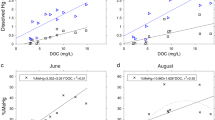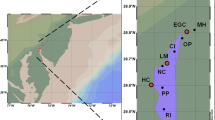Abstract
Mercury is a globally distributed pollutant that biomagnifies in aquatic food webs. In the United States, 4,769 water bodies fail to meet criteria for safe fish consumption due to mercury bioaccumulation. Although the majority of these water bodies are affected primarily by atmospheric deposition of mercury, legacy contamination from mining or industrial activities also contribute to fish consumption advisories for mercury. The largest mercury impairment in Virginia, a 130-mile stretch of the South and South Fork Shenandoah rivers, is posted with a fish-consumption advisory for mercury contamination that originated from mercuric sulfate discharges from a textile facility in Waynesboro, Virginia, between 1929 and 1950. Although discharges of mercury to the river ceased >60 years ago, mercury levels in fish remain greater than levels safe for human consumption. This is due to the continued cycling of historic mercury in the river and its eventual uptake and biomagnification through aquatic food webs. This study investigated the relative importance of waterborne versus sediment-borne mercury in controlling biological uptake of mercury into the aquatic food web. Twelve artificial stream channels were constructed along the contaminated South River in Crimora, Virginia, and the uncontaminated North River in nearby Port Republic, Virginia, to provide four experimental treatments: a control with no Hg exposure, a Hg in sediment exposure, a Hg in water exposure, and a Hg in sediment and water exposure. After 6 weeks of colonization and growth, algae in each treatment was collected and measured for mercury accumulation. Mercury accumulation in water-only exposures was four times greater than in sediment-only exposures and was equivalent to accumulation in treatments with combined water and sediment exposure. This indicates that mercury in the water column is much more important in controlling biological uptake than mercury in near-field sediments. As a result, future remediation efforts need to focus on strategies that either remove mercury from the water column or decrease flux to the water column.







Similar content being viewed by others
References
Beaulieu KM, Button DT, Scudder Eikenberry BC, Riva-Murray K, Chasar LC, Bradley PM, et al. (2012) Mercury bioaccumulation studies in the National Water-Quality Assessment Program—Biological data from New York and South Carolina, 2005–2009. United States Geological Survey Data Series 705
Bergeron CM, Husak JF, Unrine JM, Romanek CS, Hopkins WA (2007) Influence of feeding ecology on blood mercury concentrations in four species of turtles. Environ Toxicol Chem 26(8):1733–1741
Bergeron CM, Bodinof CM, Unrine JM, Hopkins WA (2010) Mercury accumulation along a contamination gradient and nondestructive indices of bioaccumulation in amphibians. Environ Toxicol Chem 29(4):980–988
Bloom NS (1992) On the chemical form of mercury in edible fish and marine invertebrate tissue. Can J Fish Aquat Sci 49:1010–1017
Boudou A, Ribeyre F (1997) Mercury in the food web: accumulation and transfer mechanisms. In: Sigel A, Sigel H (eds) Metal ions in biological systems, vol 34. Marcel Dekker, New York, pp 289–320
Brent RN, Kain DG (2011) Development of an empirical nonlinear model for mercury bioaccumulation in the South and South Fork Shenandoah Rivers of Virginia. Arch Environ Contam Toxicol 61(4):614–623
Carter LJ (1977) Chemical plants leave unexpected legacy for two Virginia Rivers. Science 198:1015–1020
Choi SC, Chase T, Bartha R (1994) Metabolic pathways leading to mercury methylation in Desulfovibrio desulfuricans LS. Appl Environ Microbiol 60(11):4072–4077
Compeau GC, Bartha R (1985) Sulfate reducing bacteria: principal methylators of mercury in anoxic estuarine sediments. Appl Environ Microbiol 50:498–502
Cristol DA, Brasso RL, Condon AM, Fovargue RE, Friedman SL, Hallinger KK et al (2008) The movement of aquatic mercury through terrestrial food webs. Science 320(5874):335
Eggleston J (2009) Mercury loads in the South River and simulation of mercury total maximum daily loads (TMDLs) for the South River, South Fork Shenandoah River, and Shenandoah River—Shenandoah Valley, Virginia. United States Geological Survey Scientific Investigations Report 2009–5076. USGS, Richmond, VA
Flanders JR, Turner RR, Morrison T, Jensen R, Pizzuto J, Skalak K, Stahl R (2010) Distribution, behavior, and transport of inorganic and methylmercury in a high gradient stream. Appl Geochem 25:1756–1769
Gilmour CC, Krabbenhoft D, Orem W, Aiken G, Roden E (2007). Appendix 3B-2: Status report on ACME studies on the control of mercury methylation and bioaccumulation in the Everglades. In: 2007 South Florida Environmental Report. South Florida Water Management District, West Palm Beach, FL
Harada M (1995) Minamata disease: methylmercury poisoning in Japan caused by environmental pollution. Crit Rev Toxicol 25:1–24
Harris RC, Rudd JWM, Amyot M, Babiarz CL, Beaty KG, Blanchfield PJ et al (2007) Whole-ecosystem study shows rapid fish-mercury response to changes in mercury deposition. Proc Natl Acad Sci USA 104(42):16586–16591
Harris R, Dyer JA, Flanders JR, Pizzuto J, Landis RC (2012) Conceptual model of mercury cycling and bioaccumulation for the South River, VA, Final Report. DuPont Corporate Remediation Group, E.I. DuPont de Nemours and Company, Wilmington, DE
Hill WR, Stewart AJ, Napolitano GE (1996) Mercury speciation and bioaccumulation in lotic primary producers and primary consumers. Can J Fish Aquat Sci 53:812–819
Jackson AK, Evers DC, Folsom SB, Condon AM, Diener J, Goodrick LF et al (2011) Mercury exposure in terrestrial birds far downstream of an historical point source. Environ Pollut 159:3302–3308
Kamman NC, Burgess NM, Driscoll CT, Simonin HA, Goodale W, Linehan J et al (2005) Mercury in freshwater fish of northeast North America: a geographic perspective based on fish tissue monitoring databases. Ecotoxicology 14:163–180
Kim EH, Mason RP, Porter ET, Soulen HL (2006) The impact of resuspension on sediment mercury dynamics, and methylmercury production and fate: a mesocosm study. Mar Chem 102(3):300–315
Lawrence AL, Mason RP (2001) Factors controlling the bioaccumulation of mercury and methylmercury by the estuarine amphipod Leptocheirus plumulosus. Environ Pollut 111(2):217–231
Mason RP, Reinfelder JR, Morel FMM (1995) Bioaccumulation of mercury and methylmercury. Water Air Soil Pollut 80:915–921
Neufeld DSG (2010) Mercury accumulation in caged Corbicula: rate of uptake and seasonal variation. Environ Monit Assess 168:385–396
Orihel DM, Paterson MJ, Gilmour CC, Bodaly RA, Blanchfield PJ, Hintelmann H et al (2006) Effect of loading rate on the fate of mercury in littoral mesocosms. Environ Sci Technol 40(19):5992–6000
Pak KR, Bartha R (1998) Mercury methylation and demethylation in anoxic lake sediments and by strictly anaerobic bacteria. Appl Environ Microbiol 64:1013–1017
Pizzuto J (2012) Predicting the accumulation of mercury-contaminated sediment on riverbanks—An analytical approach. Water Resour Res 48(7): W07518
Pizzuto J, O’Neal M (2009) Increased mid-twentieth century riverbank erosion rates related to the demise of mill dams, South River. Virginia. Geology 37(1):19–22
Rhoades EL, O’Neal MA, Pizzuto JE (2009) Quantifying bank erosion on the South River from 1937 to 2005, and its importance in assessing Hg contamination. Appl Geogr 29(1):125–134
Skalak K, Pizzuto J (2010) The distribution and residence time of suspended sediment stored within the channel margins of a gravel-bed bedrock river. Earth Surf Processes Landforms 35:435–446
State Water Control Board (1980) Mercury contamination of the South, South Fork Shenandoah, and Shenandoah Rivers, Basic Data Bulletin 47. State Water Control Board, Commonwealth of Virginia, Richmond, VA
Stokes PM, Dreier SI, Farkas MO, McLean RAN (1983) Mercury accumulation by filamentous algae: a promising biological monitoring system for methyl mercury in acid-stressed lakes. Environ Pollut 5(4):255–271
Tom KR, Newman MC, Schmerfeld J (2010) Modeling mercury biomagnification (South River, Virginia, USA) to inform river management decision making. Environ Toxicol Chem 29:1013–1020
Tsui MTK, Finlay JC, Nater EA (2009) Mercury bioaccumulation in a stream network. Environ Sci Technol 43(18):7016–7022
United Sates Environmental Protection Agency (1997) Mercury study report to Congress, Volume III: Fate and transport of mercury in the environment. EPA-452/R-97-005. Office of Air Quality Planning & Standards and Office of Research and Development, USEPA, Washington, DC
United Sates Environmental Protection Agency (1998) Method 1630: Methyl mercury in water by distillation, aqueous ethylation, purge and trap, and cold vapor atomic fluorescence spectrometry. Office of Water, USEPA, Washington, DC
United Sates Environmental Protection Agency (2001) Water quality criterion for the protection of human health: Methylmercury. EPA-823-R-01-001. Office of Science and Technology, Office of Water, USEPA, Washington, DC
United Sates Environmental Protection Agency (2002) Method 1631, Revision E: Mercury in water by oxidation, purge and trap, and cold vapor atomic fluorescence spectrometry. EPA-821-R-02-019. Office of Water, USEPA, Washington, DC
Virginia Department of Environmental Quality (2009) Total maximum daily load development for mercury in the South River, South Fork Shenandoah River, and Shenandoah River, Virginia. Virginia Department of Environmental Quality, Richmond, VA
Wada H, Yates DE, Evers DC, Taylor RJ, Hopkins WA (2010) Tissue mercury concentrations and adrenocortical responses of female big brown bats (Eptesicus fuscus) near a contaminated river. Ecotoxicology 19(7):1277–1284
Watras CJ, Bloom NS (1992) Mercury and methylmercury in individual zooplankton: implications for bioaccumulation. Limnol Oceanogr 37:1313–1318
Watras CJ, Back RC, Halvorsen S, Hudson RJM, Morrison KA, Wente SP (1998) Bioaccumulation of mercury in pelagic freshwater food webs. Sci Total Environ 219:183–208
Yu RQ, Flanders JR, Mack EE, Turner R, Mirza MB, Barkay T (2012) Contribution of coexisting sulfate and iron reducing bacteria to methylmercury production in freshwater river sediments. Environ Sci Technol 46(5):2684–2691
Acknowledgments
This research was funded by a Grant from DuPont. The authors thank members of the South River Science Team for input and review. Special thanks also goes to the Augusta Forestry Center and individuals who assisted in the project: Scott Gregory, Spencer Davis, Kurt Drummond, Brandon Foltz, and Josh McLaughlin.
Author information
Authors and Affiliations
Corresponding author
Rights and permissions
About this article
Cite this article
Brent, R.N., Berberich, D.A. Use of Artificial Stream Mesocosms to Investigate Mercury Uptake in the South River, Virginia, USA. Arch Environ Contam Toxicol 66, 201–212 (2014). https://doi.org/10.1007/s00244-013-9964-7
Received:
Accepted:
Published:
Issue Date:
DOI: https://doi.org/10.1007/s00244-013-9964-7




